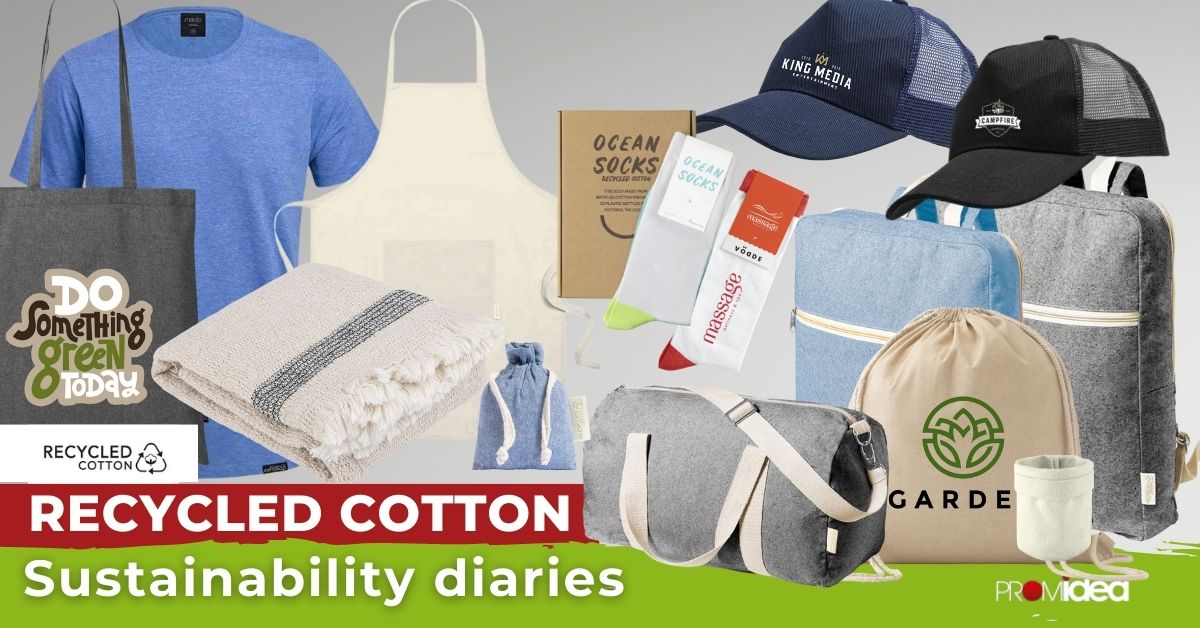Definition:
Recycled cotton is primarily made from pre-consumer cotton which is excess textile waste from clothing production. It is less commonly made from post-consumer cotton which is discarded textile waste from consumers such as second hand clothing. The recycling process includes assessing the quality of cotton fibers through systematics collection, manually sorting the materials, and undergoing a mechanical or chemical process to break down the textile fabric into reusable fibers.In the mechanical process, fabrics are torn into individual fibers through a machine, and in the chemical process, the fabrics's chemical properties are broken down through chemical reaction processes such as Lyocell process and dissolution in ionic liquids.This converted fibers can be reused into other textile products.
Key points
Recycle & Upcycle as Sustainable alternatives
Cotton is an incredibly versatile material and can be produced organically. However, if you’re looking for the most eco-conscious cotton, recycled cotton is one of the best options out there. Recycled or upcycled cotton is made using post-industrial and post-consumer cotton waste.
Recycled cotton is the most sustainable alternative to both traditional cotton and organic cotton. It bypasses the use of billions of liters of water in its production while keeping cotton clothes out of the landfill. These two reasons alone make it one of the most sustainable fibers on the market.
Recycled cotton can also be cotton fabric that is reused to create something new before it is broken down. This process is often called upcycling over recycling. For example, in upcycling, a set of cotton t-shirts might be used to create a quilt, or a cotton bed sheet, may be used to make a cotton dress, or can be cut into yarn and crocheted to create a whole new clothing piece like a hat or a scarf, or even a blanket.
Large pieces of cotton clothing like saris can be quilted together using a traditional sewing method in India called Kantha that can be used to create entirely new and unique clothing items.
In the recycling process the amount of energy, water, and dye use is reduced from using a product that has already been processed.
Annual textile waste is estimated to equal 25 billion pound, 95% of the clothing that is discarded could be reused and as an estimation, around 15% of the millions of fabrics that are manufactured annually are discarded and thrown in landfills.
Waste Reduction
It is a great way to reuse pre-consumer cotton waste from the manufacturing of cotton products and the post-consumer waste of unwearable cotton products.
Consider how everything from your t-shirts to your bedsheets has to be cut out of a roll of fabric. What happens to those fabric scraps that are too small or not worth the time to be made into other items?
Many companies already sell their waste to companies that use cotton waste to create new items. This is called the pre-consumer cotton and it can be transformed in anything from washcloths and rug pads to whole clothing,bags or other lines .
Post-consumer cotton waste is when a garment is no longer able to be worn or used anymore. Instead of these items ending up in landfills, these items can be collected, sorted, broken down, and reused to make other cotton products or even stuffing and insulation.
Recycled cotton can have its drawbacks and obstacles, and there are definitely still challenges to be tackled around quality and chemical protection. Still, it is worth taking note of the ability these fabrics have to reduce the effect of fashion on the environment.
Carbon Footprint : Low emission of CO2
Recycling cotton will also help in reducing the carbon footprint on the earth. The clothes that end up in landfills are burned in most cases, which releases up to 10% of the world’s carbon emission. Processes like dyeing also impact the emission of CO2. The recycled cotton may already have the necessary color needed for reuse, which prevents the need to add more colors and chemicals, which in the process reduces the emission of CO2.
Water Conservation
Not only does recycling cotton waste save precious space on our planet earth, but recycling cotton also helps cut down on commercial water usage. This decrease in water usage protects our wildlife from herbicides, pesticides, insecticides, and fertilizers that are used to grow new virgin cotton.
Recycling cotton can save up to 20,000L of water that is consumed for making 1Kg fresh organic cotton. Cotton recycling plants can reduce water consumption. Did you know that cotton production is the reason for the disappearance of the Aral Sea in Central Asia? With the help of quality recycled cotton, there will be less need for the production of organic water.
Where Can You Recycle Cotton
Recycle Cotton Is the Future ! As a consumer, it is our responsibility to know where we can recycle our cotton clothing and what recycling this clothing does to protect our environment today and our environment for our children and grandchildren.
It might not be as easy to recycle textiles as tossing things into a bin, dragging them to the curb, and waiting for someone else to pick them up, but that doesn’t mean it’s impossible.
The general population needs to know that they can dispose of their non-wearable cotton clothing through several organizations that make it easy to do so. Check in and around your area for clothing recycling bins, many of which will take clothes in any condition and drop off your pieces free of charge.
Be sure you are only donating usable and wearable clothing to Habitat Stores, Goodwills, and Salvation stores. They may recycle some fabrics, but in some cases, they still dispose of unwearable fabrics via the garbage.
To ensure that your unwearable clothes don’t end up in a local landfill or in a landfill across the ocean, do the research, and become an informed consumer. Know where you can recycle what fabrics, shoes, clothing types, and more even before you buy.
Promidea is encourage you to react. We are all agents of change, we can make this world a fairer and more sustainable place with our daily actions, especially with our purchases.
Does recycled cotton convince you? Share your thoughts!
As a conclusion, cotton is one of the most popular and plentiful natural materials used in the textile industry. It is all-natural and biodegradable, and it makes a strong but soft and breathable fabric. Stay tunned to find more about sustainable materials in the <<Sustainaible Diaries>>. Next we will talk about Organic Cotton and the benefits of using it as a eco-friendly alternative instead of traditional cotton.
Sources:
https://trashisfortossers.com/how-to-recycle-old-clothing
https://earth911.com/living-well-being/style/recycled-clothing-fabrics/
https://www.theconsciouschallenge.org/ecologicalfootprintbibleoverview/water-clothing
http://textileaid.blogspot.com/2019/03/recycled-cotton-benefits-and-challenges.html




